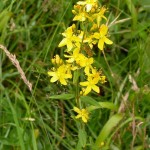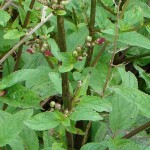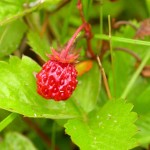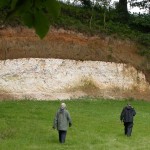John Lerpiniere led a field trip to the woods above Rushall Farm, Bradfield on Saturday 7th July. The walk started out along the edge of a wheat field above the chalk pit. Colin Dibb explained that the organic farm has a 6-year rotation, with 3 years of grass and clover, grazed by sheep and cattle, to enrich the soil, followed by a year of wheat – the hungriest but most profitable crop, followed by 2 years of less-demanding crops, such as barley. The route then led through Owlpit Copse and into the first of the small meadows in the woods. The field trip had been specially planned to coincide with the flight periods of the White Admiral and Silver-washed Fritillary butterflies, but on a morning of continuous cloud cover, none were on the wing. Meadow Brown, Ringlet and Marbled White butterflies were all seen, together with single specimens of Small Skipper and Red Admiral.
A delicate St John’s-wort plant with orange buds was identified as Slender St John’s-wort. Further on, a more robust plant with pale yellow flowers and buds and downy stem and leaves was identified as Hairy St John’s-wort. Later, a big clump of Perforate St John’s-wort was also found. A significant proportion of the Marsh Thistle flowers were white, rather than purple, and there were some pink Self-heal flowers, as well as the more usual purple specimens. Some of the Common Spotted-orchids had white flowers, and these plants all seemed to have leaves without spots. The second small meadow had figwort plants with square 4-winged stems and bluntly tipped leaves which were identified as Water Figwort. Field-rose, with white flowers and a pointed style, was found near the top of the field. A dense matt of red clover with narrow dark green leaves and dark red flowers was identified as Zigzag Clover. Wild Strawberries provided a delicious snack.
The return route led back down through Owlpit Copse and into a very muddy field where a group of cub scouts were camping. Finally, the exposed face of the chalk pit was inspected, with white chalk from the Cretaceous period, laid down about 85 million years ago, at the bottom. This was eroded for about 30 million years, before the next layers were deposited unconformably. The thin dark layer above the chalk, containing sharks’ teeth, is supposed to date from the time of the mass extinction of the dinosaurs, 57 million years ago. Traces of iridium are thought to have an extra-terrestial origin. Above are orange layers of sands and clays from the Reading beds.
Pictures by Chris Ash and Jan Haseler
List for Owlpit Copse, Rushall Farm, Bradfield from RDNHS field trip on Saturday 7th July 2012, led by John Lerpiniere
Plants
Lesser Stitchwort Stellaria graminea
Perforate St John’s-wort Hypericum perforatum
Hairy St John’s-wort Hypericum hirsutum
Slender St John’s-wort Hypericum pulchrum
Creeping Willow Salix repens
Field-rose Rosa arvensis
Tormentil Potentilla erecta
Zigzag Clover Trifolium medium
Selfheal Prunella vulgaris
Wood Sage Teucrium scorodonia
Water Figwort Scrophularia auriculata
Thyme-leaved Speedwell Veronica serpyllifolia
Heath Speedwell Veronica officinalis
Honeysuckle Lonicera periclymenum
Marsh Thistle Cirsium palustre
Common Spotted-orchid Dactylorhiza fuchsii
Crested Dog’s-tail Cynosurus cristatus
Wood Melick Melica uniflora
Sweet Vernal-grass Anthoxanthum odoratum
Yorkshire-fog Holcus lanatus
Butterflies
Small Skipper
Red Admiral
Marbled White
Meadow Brown
Ringlet
Moths
Crambus pascuella
Silver Y
Birds
Green Woodpecker
Great Spotted Woodpecker






